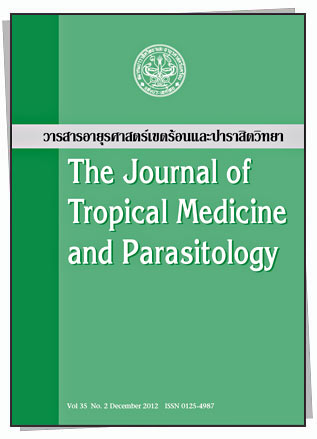A Comparative Analysis of Serpin Genes and Recombinant Proteins from the Salivary Glands of Thai Cattle Ticks, Rhipicephalus microplus
Main Article Content
Abstract
Abstract
The cattle tick, Rhipicephalus microplus, is the main ectoparasite of livestock in tropical countries, inThailand particularly. This tick causes a range of problems, including anemia, widespreadproduction losses, as well as lethal tick-borne diseases in animals. Control of tick infestations isbased on the use of chemical acaricides, which have numerous undesirable side-effects, for example,environmental pollution and contamination of the food animals eat. This has led to the developmentof alternative, environmentally friendly methods of tick control, such as anti-tick vaccines. Ticksalivary gland (TSG) proteins are one potential source of vaccine candidates. Molecules secretedfrom the TSG modulate the vertebrate host immune response, and are thus potential targets fornovel tick-control measures. TSG serine protease inhibitor (serpin) is one such molecule, which mayfacilitate tick feeding, blood meal digestion, and pathogen transmission. In this study, we clonedserpin cDNA from the TSG of the cattle tick (R. microplus) by reverse transcriptase-PCR, and analyzedtheir nucleotides and deduced amino-acid sequences. The results demonstrated that 10 serpin cDNA1,200 bp in length encoded a serpin protein with 399 amino acid residues, which were 96-98%identical to each other. Based on this result, recombinant serpin protein might be used as an antigenin anti-tick vaccines against R. microplus in numerous regions. TSG serpins of Thai R. microplus wereclustered into groups of serpins belonging to each tick species. Phylogenic analysis of other serpinsin the GenBank database indicated that Thai serpin sequences contained minor variations in theiramino-acid residues, compared with other tick serpins. Greater numbers of variations have beenshown for other arthropods.
Keywords: serpin gene; Rhipicephalus microplus; phylogenetic analysis; salivary gland; Thailand

